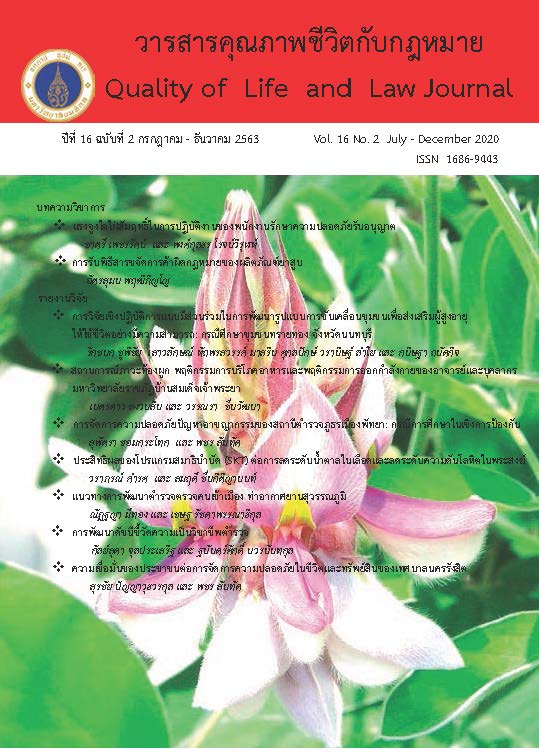Constipation Situation Food Consumption Behavior and Exercise Behavior of Lecturer and Personnel Staff at Bansomdejchaopraya Rajabhat University
Main Article Content
Abstract
The cross-sectional descriptive studies were to study constipation situation food consumption behavior and exercise behavior of lecturer and personnel staff at Bansomdejchaopraya Rajabhat University and to study the relationship between demographic characteristic knowledge food consumption behavior and exercise behavior with constipation. The sample selected by systematic random sampling were 470 people. A questionnaire was used to collect relevant data. The statistics include descriptive and chi-square test.
The results found that 14.30% of lecturer and personnel staff had constipation situation had knowledge of food consumption and exercise at moderate. Food consumption behavior and exercise behavior were moderate level. It was found that food consumption behavior and exercise behavior relationship with constipation significant at the 0.05 level but gender, age, working status, average monthly income, congenital disease and knowledge were not significant at the 0.05 level.
The results of this study suggested that university should be support and promote lecturer and personnel staff to have food consumption behavior with increased fiber and to have exercise behavior for they good health.
Article Details
- บทความหรือข้อคิดเห็นใดๆ ในวารสารคุณภาพชีวิตกับกฎหมายเป็
- กองบรรณาธิการไม่สงวนสิทธิ์
References
กองสุขศึกษา. (2558). การปรับเปลี่ยนพฤติกรรมการบริโภคอาหารสำหรับวัยทำงาน. กรมสนับสนุนบริการสุขภาพ กระทรวงสาธารณสุข.
จันทร์อาภา ธนธรรมสถิตย์. (2559). ปัจจัยที่มี ความสัมพันธ์กับภาวะท้องผูก ในผู้สูงอายุโรคไตวายเรื้อรังระยะสุดท้ายที่ได้รับการบำบัดทดแทนไต. วารสารการพยาบาลและการดูแลสุขภาพ ,34(4),28-36
นงลักษณ์ ลิ้มกุล. (2552). ประสิทธิผลและความปลอดภัยของการใช้ยาเม็ดมะขามแขกในการรักษาภาวะท้องผูกเรื้อรังในผู้ป่วยไตวายระยะสุดท้าย.(วิทยานิพนธ์ (ภ.ม.)). จุฬาลงกรณ์มหาวิทยาลัย.
พูลชัย จรัสเจริญวิทยา. (2554). ท้องผูก:ความชุกของโรค. สาขาวิชาโรคระบบทางเดินอาหารภาควิชาอายุรศาสตร์ คณะแพทยศาสตร์ศิริราชพยาบาล.
ภวัต เลิศสุธน. (2555). พุทธศาสนากับการจัดการปัญหาสุขภาพที่สลับซับซ้อน. ค้นจาก http://www.stou.ac.th/Schools/Shs/booklet/book55_4/culture.html
มยุรา วัฒนพงศ์ไพศาล และคณะ. (2558). ผลของการบริโภคน้ำผักผลไม้ผสมใยอาหารต่อการขับถ่ายอุจจาระในผู้ที่มีภาวะท้องผูก. วารสารสาธารณสุขศาสตร์, 45(2), 210-224.
มูลนิธิโรม. (2006). เกณฑ์โรม III. Gastroenterological,12(1),15.
วาสนา บุญปัญญา และคณะ. (2554). ผลของโปรแกรมป้องกันอาการท้องผูกสำหรับผู้ป่วยระบบประสาท. รามาธิบดีพยาบาลสาร ,18(2),237-248.
สุขประเสริฐ จุฑากอเกียรติ. (2555). พึ่งยาระบายเป็นประจำทำให้ลำไส้เป็นอัมพาต. ค้นจาก http://news.thaipbs.or.th/content/129314
AbdulRhman AlDukhayel, et al.(2009) Constipation is closely associated with depression in patients with end-stage renal disease undergoing hemodialysis or peritone aldialysis. Korean J Nephrol 28,610-616
Department of Internal Medicine, University of Michigan Division of Gastroenterology.(2004). Epidemiology of constipation in North America: a systemic review. AmJ Gastroenterol 99,740-750
Green, L.W., & Kreuter, M.W. (1999). Health promotion planning: An education and ecological approach (3 ed.). Mountiain: Mayfield publishing.
Mueller and Lissner, et al. (2009). Survey of laxative use by adults with self-definer constipation in South America and Asia: a comparison of six countries. Aliment
Pharmacol Ther 31: 274-284
World Gastroenterology Organisation Global Guidelines. (2010). Constipation: a global perspective. World Gastroenterology Organization:1-13.
World Gastroenterology Organization [WGO]. (2007). Constipation practice guideline. Retrieved from http://www.worldgastroenterology.org/assets//downloads/en/pdf/guidelines/05constipation.pdf
Yamane, T. (1970). Statistics: An Introductory Analysis. Harper International Edition,Tokyo: 580 – 581.


